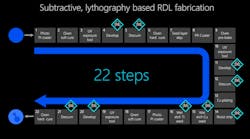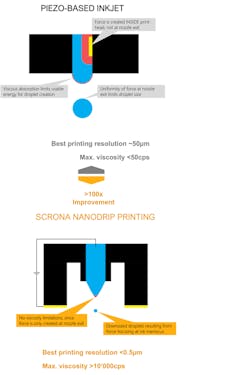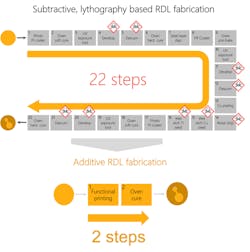READ MORE: Nanoparts that Change Shape and Hold It
Imagine having the ability to digitally print the impossible with sub-micrometer precision, on any material and at scale. A spin-off out of ETH Zurich has done just that. Walter Braun, chief operating officer of Scrona AG, told Machine Design how the company is now setting its sights on transforming manufacturing of semiconductor, display and many other products.
Machine Design: I hear that Scrona holds the world record for the smallest-ever printed color photo and now you have developed the industry’s first multi-nozzle printhead that can scale to 0.5 μm? Tell us about your company.
Walter Braun: Founded in 2014, Scrona is a spinoff from ETH Zurich, one of the top 10 global research universities. We developed the industry’s first electrostatic multi-nozzle 3D printing platform that can digitally print the impossible with sub-micrometer precision, on any material and at scale, improving and speeding manufacturing for today and tomorrow’s products.
Scrona’s patented electrostatic printing technology has the potential to transform manufacturing of semiconductor, display and many other products with its ability to reduce production steps tenfold, while also dramatically reducing materials, energy and water usage.
MD: How is this different from traditional inkjet printing?
WB: Existing technologies, such as traditional inkjet printing, have gained a lot of traction in graphical printing replacing non-digital technologies and even laser printers. On top of that, inkjet successfully moved into functional printing of certain features on PCBs and displays. However, incumbent inkjet printing technologies have now reached their physical limitations and cannot deliver the ultra-high resolution and placement accuracy that is needed to be effective and affordable.
In the case of inkjet printing, the schematic below illustrates the way conventional technology works: Liquid is pressed from the inside of fine nozzles, creating tiny ink droplets. The problem with this actuation process is that it only allows the ejection of thin inks, which are then flattened on the substrate due to their high fluidic content. The actuated droplets are no smaller than the size of the nozzle from which they were ejected. This conventional pushing concept physically limits nozzle sizes to a few tens of micrometers and thereby makes it unable to reach the ultra-high resolution that is needed for microfabrication.
READ MORE: Additive Manufacturing Technology Takes the Focus at MD&M West
Scrona has developed a new and alternative approach, which is to use an electrostatic force that pulls the liquid out of the nozzle, forming a pointed cone and focusing all energy to the tip of that cone. It is from this tiny tip that small droplets are ejected, accelerated and guided downward. Due to the force-focusing effect, droplets are no more limited to the size of the nozzle, but can in fact become more than 10 times downscale.
Since no force needs to be guided to the nozzle exit from the inside of the nozzle, the technology becomes essentially agnostic to ink thickness, allowing both thin and thick fluids to be processed almost equally. Small droplets can be placed accurately onto the substrate and the small volumes dry quickly and form into 3D projects smaller than 1 µm in lateral dimension.
Because the electrostatic ejection principle is more or less ink-agnostic, it opens the door to use a wide variety of inks. These inks can be at least 100× more viscous than inks used in today’s conventional inkjet printheads. In theory, it could even be possible to print with honey. This ability to print with many types of fluid expands use cases besides typical nanoparticle metal inks into a wide range of materials, such as:
- Molecules and salt solutions
- Nano- and microparticles and proteins
- Melts, waxes and epoxies
Leveraging electrostatic ejection principles, it is possible to achieve simultaneous printing from a large nozzle array, with the following advantages compared to conventional inkjet:
- Ultra-high-resolution printing—100× higher resolution
- High-speed printing—10× higher ejection frequency
- Smaller droplets not only for higher precision but also for fast drying
- 3D printing. Aspect ratios >50:1 possible, nanometer layer thickness control
- MEMS printhead customization, dynamically and fully programmable
- Prevention of nozzle clogging by proprietary Environmental Control System (ECS)
MD: What are the implications for this technology for semiconductor manufacturing?
WB: The ability to print on any material, at scale, can improve the speed, accuracy and cost of producing innovative products for today and tomorrow. The semiconductor and display manufacturing industries are ideal targets for additive manufacturing to reduce their production complexity [and] high-cost as well as high-water and energy usage while delivering the high resolution needed.
As the below graphics depicts, this could reduce manufacturing steps of certain semiconductor back-end components 10-fold, while also significantly reducing material, energy and water usage. With multiple steps—over 20 required for one single feature layer on a semiconductor device—fabrication can take up to 15 weeks, with 11-13 weeks being the industry average. In addition, a semiconductor fab may use between 2 to 4 million gallons of UPW (ultra-pure water) every day, which is approximately equivalent to the water use of 40,000 households.
READ MORE: Going Mainstream: Additive Manufacturing Bolsters Production Methods
Other markets can also be transformed by this type of technology. For example, the yet unseen resolution and layer thickness control can enable printing of quantum dot RGB color filters for high-brightness, full-color micro-LED displays in augmented reality glasses for gaming and metaverse applications. It can also be used for HD-PCB/printed electronics, MEMS and sensors, life sciences and security printing.
MD: What is your vision for the future?
WB: From the very beginning in the research lab, it has been our vision to make the ultra-high resolution capabilities of electrostatic printing scalable in order to bring the technology into high-volume manufacturing. For an inkjet technology that meant inventing a way of forming thousands of nozzles, including their fluidic and electric infrastructure for each nozzle on a smallest possible area, because one single capillary-type nozzle as it was used in our lab is simply too slow to gain economics.
We achieved this through MEMS microfabrication technology, leveraging many proprietary tools and processes. Our vertical integration and thorough understanding of the underlying physics and electro-chemistry are the foundation of our breakthrough additive manufacturing technology.
We see our additive technology as a sustainable and very effective way to reduce complexity, material consumption and cost in high-volume microfabrication. The user directly prints what is needed, where it is needed from a digital file. No need for photomasks and subtractive manufacturing techniques as well as support processes.


